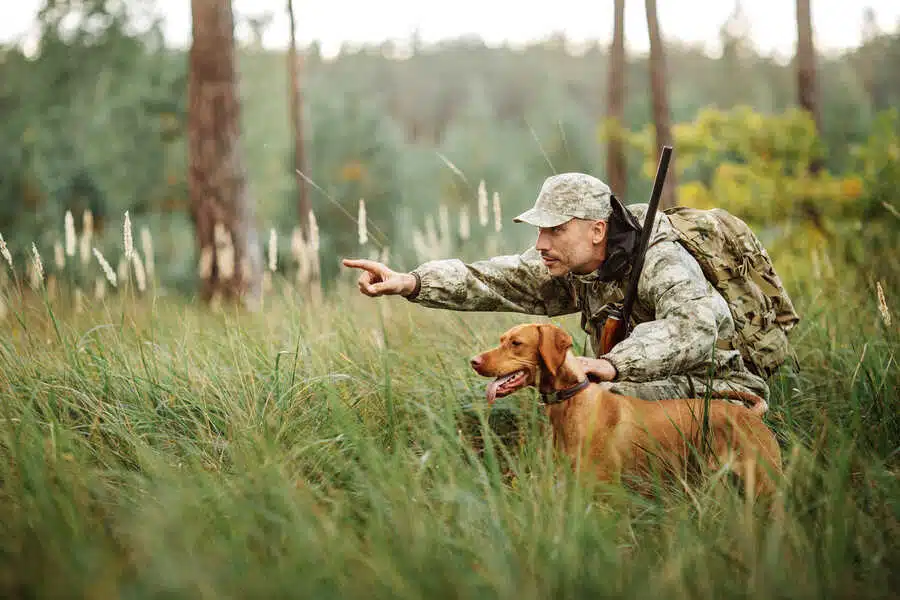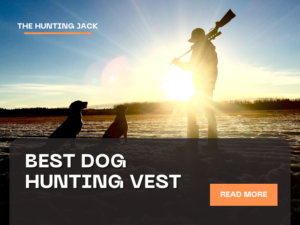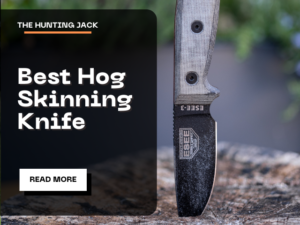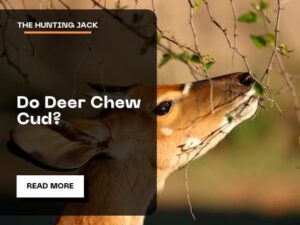Having a dog by your side when you are out hunting is probably one of the most rewarding feelings. Not only will your day be less boring but you will also have your loyal companion along your side. Friendship aside, that same companion can help you track, hunt, scare out in the open, or retrieve different game you are after. The combination of a helpful hunting partner and a barking lump of joy is why more and more hunters nowadays opt for having a hunting dog.
There are a lot of key factors that you need to take into consideration when raising your puppy to become a fierce hunter. That is why knowing how to train your dog to hunt is so important. There are steps that you need to go through and dedicate a lot of time to in order for it all to be worth it and for your dog to become great at his job. In this article, I will take you through those steps and show you exactly what you need to do day-by-day and month-by-month in order to raise a proper hunter.
The best way to properly train a hunting dog is to get it while it is young. That way, apart from creating a trustworthy hunting companion, you will also create a loving lifelong friend that is very obedient. I am not saying that you cannot go through this training process with an older dog but since most people start from scratch, that is where we will begin as well.
Since I tried to cover everything regarding this topic, feel free to use the table of contents below to jump to the specific game you want to train your hunting dog for.
Picking the right breed
Even though most breeds are perfectly fine with being trained to hunt almost all types of game, there are specific breeds that have certain instincts developed into them through centuries worth of breeding. Getting a specialized breed will make things far easier for you since the dog will be naturally good at his job.
Since we will mostly talk about waterfowl hunting here, let’s list the top 3 breeds used for this type of game:
- The Labrador Retriever
- Golden Retrievers
- German Pointers
These breeds have specific features that allow them to be excellent swimmers and highly-adaptive hunters. Apart from their general love for the water, they have a double-layer coat, webbed feet, and a muscular body. They are also one of the most intelligent breeds out there. All that ends up creating a near-perfect companion for your waterfowl hunting days.
If you want to learn more about the different hunting breeds out there, I suggest checking out my article on some of the best dog breeds for hunting different game. There I’ve categorized dogs into groups according to their most preferred animal to hunt and chase. In other words, if you are wondering which breed will be the most appropriate for the game you are mostly after that article will be a good starting point.
Dog breeders or animal shelters?
This is a topic of endless discussion because a lot of people are against continuous selective breeding, which is starting to lead to certain genetic issues in some breeds like German Shepherds, for example.
Getting a Retriever/Labrador mix from your local shelter is a great idea if there are any. That is why you can first research your local shelters and see if they have any Retriever or Labrador pups that can be adopted. If there are none, then you might start looking for reputable breeders. If you don’t know which ones to trust, reach out to hunting or dog club forums or organizations in your area. There, people will let you know about the reputation of the breeders around you.
The advantage of getting your puppy from a breeder is that it will have a heritage and it will be slightly easier to discipline and train over time. Still, I’d like to think that it all boils down to how much time and energy you spend with your dog in its first year and how good of a bond you two build with each other. Speaking of that…
The first year of your dog’s life
Your dog’s training starts from the moment you pick it up and it will practically never end. It will grow more and more accustomed to distractions during your hunt and will become better and better at executing your commands. By that logic, a finished hunting dog is a relative term that is only something you should strive for but never something that you will actually reach.
The basics for every dog of every breed are the same. Teach the dog to go away from you, stop, and come back, and you are already halfway there. Still, every pup progresses at its own pace but I will lay out some general guidelines during your dog’s first year of training. Let’s separate these first months into four major periods:
- 2-4 months
- 5-7 months
- 8-11 months
- After the first year
2-4 Months
In this period you should focus on introducing your pup to the world. Acquaint it with different places, people, and maybe even other dogs after you get through the vaccinations. Have him meet his doctors and groomers and reward him after every visit so that he establishes a positive connection between those places and these people.
These months are the months in which it will learn what “no” means and will most likely hear it a lot. It will also get used to his or her name. A few moderate exercises will be good for the body although try avoiding intensive running or jumping since its joints aren’t fully developed yet.
Start introducing him to the process of walking around the block and get him used to his leash. It is important to not yank him as that will just create a negative connection with the whole experience of going out for a walk. If you plan on keeping the dog outside in your backyard, then these steps won’t be really necessary, although you might still want to train him to walk on a leash beside you. I will get into that later during the waterfowl training.
Remember that it is always better to praise good behavior than to punish bad ones. This is valid for all of the stages of the dog’s life.
5-7 months
Between the fifth and the seventh month teaching your dog obedience should be your main focus. These are also the months in which you teach your dog to come when called and to learn to follow your commands. In this period you also introduce methods such as the windshield-wiper or the “whoa” to potential pointers or having your flusher dog learn the “hup” command. I will get into further details about those methods further down.
Here you also start introducing your pup to water and gun sounds.
8-11 months
Around this period, pointer dogs start showing their potential, while retrievers start to bring back animal dummies. If your dog is used to gunfire, start taking it for short hunts.
After that period, your dog should have most of the commands learned well. Pointer dogs should stand any potential bird targets until they fly while flushers hup when you give the command. From then onward it is all about perfecting your bond and craft, which includes a number of other tricky methods that I will discuss in a moment.
Now that we’ve gone through what a general training regimen and progression looks like, let’s get to the nitty-gritty and see what it takes to create a highly specialized waterfowl hunter…
A 10-step program to train a waterfowl hunting dog
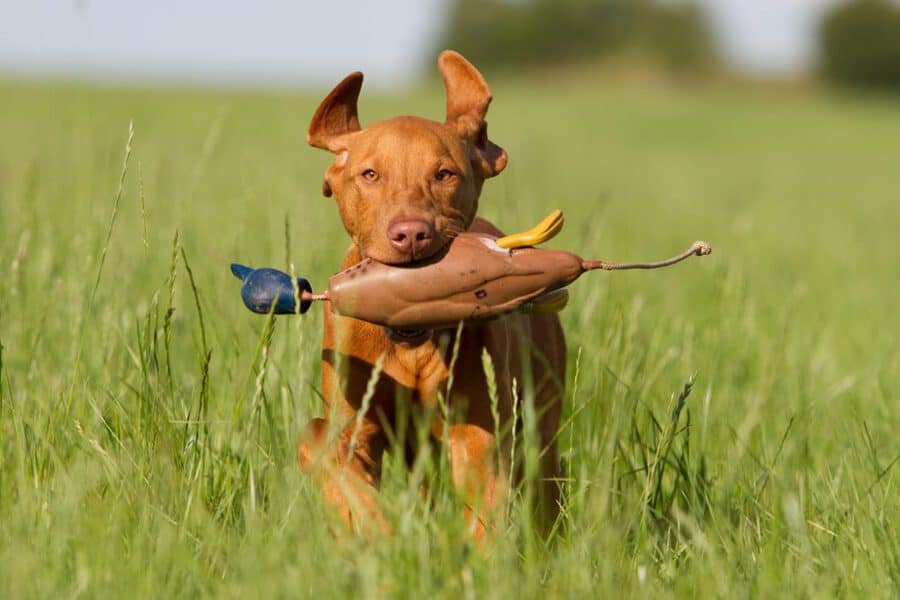
Having a dog jump in the cold water and retrieve the duck you just shot is a priceless experience. Every waterfowl hunter knows how beneficial a four-legged partner is. The teaching process for waterfowl hunting dogs isn’t the easiest and requires a steady amount of dedication throughout the pup’s first 12 months. It also isn’t a process that most breeds will adapt to nicely. Some of the best breeds for waterfowl hunting include Retrievers, Spaniels, Pointers, and Terriers.
Here is my list of all the steps you need to go through to perfect your dog’s hunting craft:
- Teach the pup basic social behavior
- Introduce it to water
- Teaching “sit” and “stay”
- Introducing the pup to waterfowl scents and decoys
- Keep practicing on a daily basis
- Rewarding the correct behavior
- Introducing the dog to normal hunting conditions
- Keep using duck dummies as often as possible
- Introducing your pup to boats (not mandatory)
- Keep thing simple
Let’s look into each one of those steps in a more in-depth manner now. Remember, the devil is in the details and there are lots of them here but the only true key to progress is consistency.
As I pointed out in the earlier chapters, before you get to the actual training you need to find a place to get the pup from and know what breed you are going after. Once you go through those steps, it is time to begin the training…
Teach the pup basic social behavior
The further you get into this article, the more you will realize that this is the first step to any type of training, not only hunting-specific. Your pup needs to get to know the world, learn the scents of different items and start responding to its name by the time you are done with this step.
The pup should get to know its leash, where to go to the toilet, and should also start walking and bonding primarily with you.
This is, in fact, the most important period when it comes to the hunter-dog bond you are creating. Make sure you don’t scold your pup but rather reward the correct and good behavior. That way it will learn easier what to do and what is a big no-no in and around the house. The same methods will be later on used to reward hunting-specific behavior and the dog will already be used to reading your signals towards what is right and what isn’t.
Introduce it to water and nature
Another very important task you have to do in the first few months (around the third month preferably) is to introduce your dog to the water.
The idea behind this is that you have to show your pup that water is good and fun, and playing in it just means more rewards and treats. If you have a pool, that will be the best place to start from. Don’t worry, since it will just take a couple of days before the pup is ready for open waters. After that, it is smooth sailing, no pun intended.
Pools and swimming in general help a lot with joint and muscle development which is great for some breeds that have joint-related issues later in their life.
Teaching “sit” and “stay”
These basic commands might seem quite cliché to you but they are going to lay out the fundamentals of your future training. When your dog is already familiar with these commands, that will open the door to more complex demands from you.
The easiest and fastest way to teach “sit” is to use a treat and show it to the pup. As soon as it focuses on it, press gently on its hind legs and repeat the command. When the pup sits, give the treat. After repeating the process over and over, soon the dog will start sitting at the sight of a treat, and sometime after that, it will do so without a treat as well.
The same method is applied to “stay”, although you could choose in what position should the dog stay. The easiest way for your pup would be to sit and then stay while you move away. That will open the door for future commands like “come”, “lay”, “heel”, and others.
Introducing the pup to waterfowl scents and decoys
One of the more important parts of the training is having the dog learn the difference between decoys and real ducks. You can do that by using dummies. Set a few decoys at a distance far away from the dog and throw the dummy somewhere closer. Let him find the dummy (which should be scented) and reward him when he finds it and returns it.
You can even introduce him to tame ducks so that he familiarizes them with their scent but more on that later.
Keep practicing on a daily basis
A step that I like to include as a separate one is a daily practice. Most people schedule a few practices per week which can work if the dog is good for the task but in most cases, puppies require constant attention and work. Remember, their attention span isn’t great at least not until they hit 6-8 months. This is why daily practices are a must, even if they aren’t really long every single day.
Leaving your dog at places that take care of the training is good but it will also remove part of the bond you two will have later on in life. That same bond is crucial when it comes to strict hunting drills and commands.
Also, don’t forget to have fun. If your dog associates waterfowl hunting with treats, praise, and pats on the head, he will forever fall in love with the activity and be a great performer once it’s time for the real thing.
Introducing the dog to normal hunting conditions
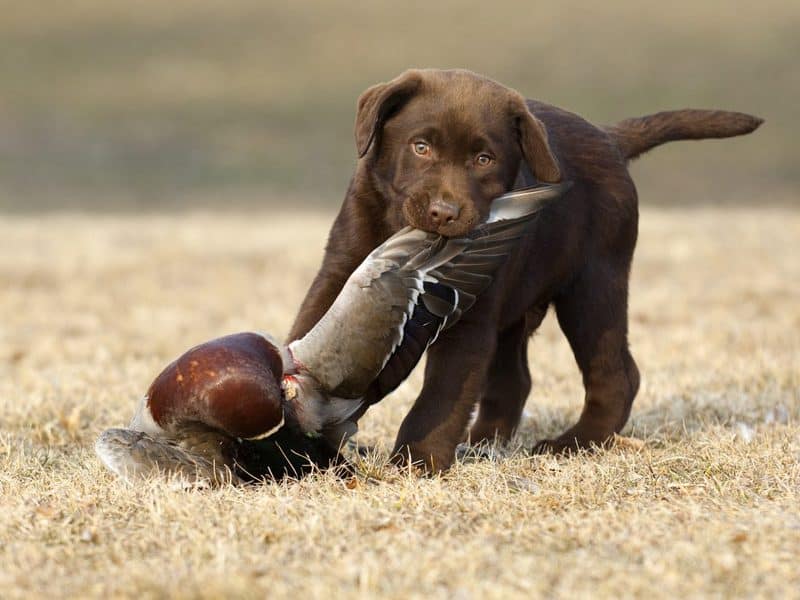
Training your pup in just raw theory might work well in controlled conditions but if you don’t get it accustomed to the real hunting environment it won’t perform well later in its life. Train your pup to stay calm around gunfire by taking it to your target practices. Also, take it out in the area in which you hunt or at least areas similar in terms of look and feel. The goal of all of that is pure and simple – conditioning your dog to actual hunting scenarios. The more you do it in a real environment, the better hunter it will grow to be.
Jack’s Tip: Wild bird camps.
These camps usually are home to a lot of wild birds which gives your dog an opportunity to get used to birds long before the hunting season starts. They also learn how to work with other dogs, work the cover, and get used to the hunter-dog relationship. Find one with lots of water in it that houses ducks, otherwise, you will predominantly find pheasants that require a slightly different approach than ducks.
In order to get your dog there, it needs to have at least the foundations for hunting any type of bird.
Rewarding the correct behavior
This is yet another step/phase that you need to deeply incorporate into your training. You shouldn’t scold the puppy when it does something wrong or misbehaves. Rather, reward it every time it does the right thing.
Don’t forget to do that in the early months (2-6). In the following months, it won’t be as important as the dog will have already gotten accustomed to your overall body language, tone, and commands.
Keep using dummies as often as possible
Scented dummies should be used as early and as often as possible. This is part of the “real-life” conditioning process and is a very important step. Introducing these scents and the feel/look of the duck too late in the training might result in poor performance later on.
The best tip one can give you here is to incorporate them as much as you can in your playtime.
Introducing your pup to boats or blinds
Where you are hunting ducks, geese, or other waterfowl, your dog should be familiar with your stronghold. Some hunters prefer going without a cover, while others like shooting from ground blinds or even boats.
Blinds and boats are two places that you need to teach your pup to recognize and respect. While in them, it needs to be quiet and still. You can do that by rewarding him every time he calms down on the boat or in the blind. Teach him to sit and observe the area with you. His job is to stay calm near you and to go fetch any time you shoot.
Keep thing simple
Remember, the goal of your whole training course is to teach your dog to retrieve the duck. This is what you should be rewarding it for. The natural instinct of the retriever will be to go after the duck and bring it back to you, this is why you should sharpen that skill with scented dummies until you perfect it. Don’t go overboard unless you want to train your dog to hunt other animals. Check the other sections here to see which steps are different when training for various big or small games.
Once all of those training steps have been mastered, it is time to go out on a real hunt. The first few times your dog can feel a little out of place or confused. That is normal since it still is going to be quite a drastic change from the normal training conditions unless you’ve acclimated the dog well enough. Make sure you keep rewarding your partner every time he does something right or brings you what you’ve shot down.
Now let’s take a look at a few other animals or things a hunting dog can be useful for.
Training your dog for rabbit hunting
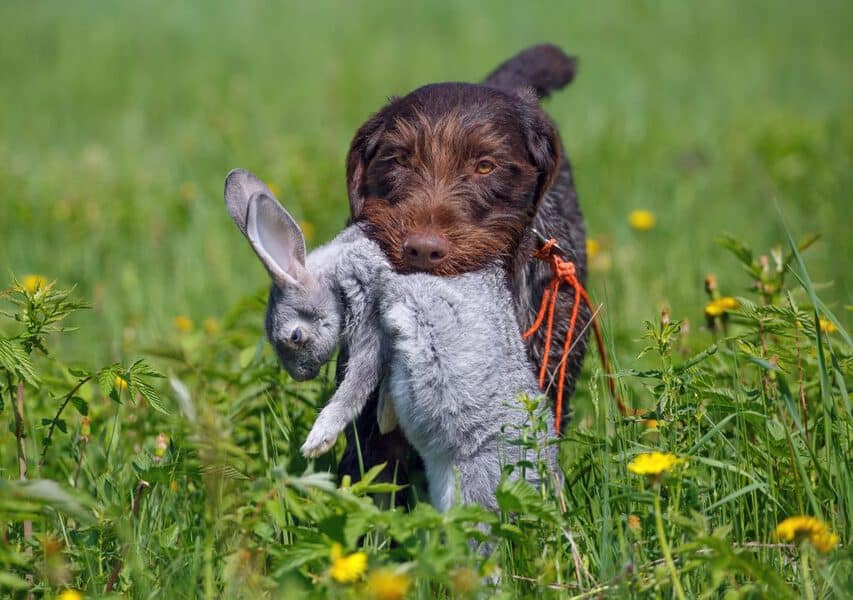
Training your dog to find, chase, or retrieve shot rabbits is essentially the same as training it for any other small game with a few tiny exceptions. Let’s go over the whole process now…
Baby steps
It all starts in the fourth week when you start teaching your dog obedience, then followed by basic commands. After a few weeks, start scattering different treats across your training area and let your pup sniff around and find them. That will calibrate it quite well, especially when there are treats at stake.
The next step is similar to what you do when training your dog to chase and hunt squirrels. You tie a tasty piece of meat (which can be a hot dog) to a string and drag it across your yard. Every 3-5 feet slice a piece of the meat and leave it there. That will reward the dog for staying on the scent and tracking it. Bonus points if you use a dead rabbit instead of a piece of meat during this step. It will familiarize the pup better with that particular scent.
The starter pen
Now comes the most important part of the training – introducing your dog to a tame rabbit. This should happen when your pup is around 3-4 months old. You can either introduce it to a rabbit within an enclosure or make your own starter pen where you can continue the dog’s training. There are also private training pens that cost a fee for every dog you train there.
You should hold the rabbit by its scruff and let the dog sniff it out very thoroughly. It should get excited about the process of chasing it almost immediately since it will perceive it as a toy.
Jack’s Tip: Tie your dog with its leash and let it watch how you chase the rabbit around the pen or enclosure. That should get him even more excited and make him want to join the chase.
After you’ve done through those initial introductory stages it’s time to let the pup chase the rabbit. If the rabbit hides behind a tree or a bush it is even better since the dog will learn how to use its nose rather than its other senses. In a thick brush environment, it will almost predominantly rely on its nose to find a rabbit.
You should let the dog chase for at least 2 hours every other day. If you don’t have that much time, you should try to do that at least once a week. Generally speaking, the more you guys train that way the better future results will be. Pay attention to aggressive behavior from the dog. It shouldn’t harm a tame rabbit but if it starts getting aggressive, end the chase and continue on another day. Usually, pups track, chase, and investigate the area and the rabbit is fairly quicker than them but keeps them under supervision just in case.
When the rabbit tires itself out from running, remove it from the enclosure, and don’t forget to congratulate the puppy. After all, that was its goal in the training. Repeat the process every time until the rabbit gasses out. Depending on your dog, this phase might take from a few days to a few weeks.
Moving to a running pen
Once you are done with the starting pen, it is time to move into a running pen. These pens are essentially the same as the starter ones but are far bigger. Here, the dog can perfect its craft and start using its nose to track the rabbit rather than its eyes. These pens can range from several yards to a hundred yards and it is far easier to join a local gundog field trial club.
Remember to always stick close to your dog, as this will strengthen your bond and will create a good team connection between you two. Trust me, nothing will get you in better shape than a few days per week in the running pen.
Jack’s Tip: Find a running pen similar to the environment you will be hunting in (temperature, amount of trees, tall grass, thick brush, etc).
Older dogs to the rescue
One of the hardest parts of tracking a rabbit will be the “check” which is a temporary loss of the trail. In these situations, your pup will greatly benefit if it is paired with older more experienced hunting dogs.
Usually, people pair their dogs with slower female dogs. The young pup will learn advanced behavior from the veteran and will improve its own techniques.
This should only be done after your puppy is able to track a trail for at least 20 minutes on its own.
If you only have a single pup, you can either pair it with a friend’s older hunting dog or ask the local gundog club for a dog to form a “brace” (two-dog pack).
During these stages, you should also start introducing your dog to gunfire and your hunting gear. Start with distant shots every now and then and move closer as your pup grows more and more accustomed to the sound. It should also get used to the scent of your gear. Introduce it to your hunting day pack, weapon, your other hunting items, and clothes. That way it will really adapt to the environment and the way you will smell during an actual hunt.
The Hunt
The rabbit hunt essentially is formed by four major elements:
- Finding the rabbit
- Letting your dog out
- Finding a good position for your shot
- Taking the shot
The first step of finding the rabbit is usually the hardest but that depends on the area in which you are hunting. Rabbits are usually found on lands that are on the edge of forests. Dry, soft land near crops on the one side and thick cover on the other is their most preferred habitat.
In terms of times of the day, rabbits are most active during dusk or dawn.
The next move is to let your dog loose. It will immediately start looking for a rabbit if it picks up a scent. If it doesn’t it might take its time to find one. The dog will move far more swiftly through thick and uneven terrain and will actually do most of the job for you. If there is more than just one dog, the one that finds the scent first will signal the others by barking.
While the dogs are doing their thing, you need to find a good spot for your shot. I prefer finding a slightly elevated position. Keep an eye on your lead dog as it will be directly behind the rabbit.
Rabbits don’t stray too far from their homes and eventually they circle around, so be patient and don’t worry if the dog(s) start straying too far away from you.
Finishing the job
When your dog or dogs flush the rabbit out in an open area, it is time to finish the job with your weapon.
If you are using a 308 rifle, I can suggest checking out my guide on some of the best scopes for 308 rifles. Even though rabbit hunting is usually considered short-range, it is always good to have a scope on top just in case your dogs flush it a bit too far from your spot.
Jack’s Tip: The ideal time to make your shot is when the rabbit creates a little bit of distance between it and the dog(s). Then, it will usually stop to scout behind it and see how far the dogs are. That is when you pull the trigger.
It is also very important to remember to always know where your dogs are. Unless you are absolutely certain that you have a clear shot at the rabbit and that your dogs are at a safe distance, don’t make the shot. Having a good shooting stick for your rifle will help you with stability and accuracy as well.
Training your dog for squirrel hunting
Dogs that hunt squirrels have two very particular qualities. They can trail the squirrel and “tree” it. Treeing basically means pinning their target onto a tree and staying at the base of the tree until the hunter comes and shoots down the squirrel.
Even though treeing is something engraved deeply into the genetics of some breeds, a squirrel hunting dog needs its habits improved and developed over time just like any other hunting dog. You can’t just go ahead and get a purpose-bred dog that will do the job from day one. Every dog requires training it is just that some require it more than others.
So, what exactly do you do if you haven’t trained a squirrel dog before? Well, let’s find out.
The first steps to squirrel training are the same as with any other type of game you’re going to train the dog for. You need to develop and strengthen the bond between you and teach the dog basic commands and obedience. It also needs to get used to gunfire and field conditions just like any other dog.
The good thing about squirrel hunting is that dogs naturally love chasing prey. This is something you need to take advantage of. The best game to play with your pup is the squirrel tail-chasing game.
Method
Tie a scented squirrel tail to one end of a rope and use it as a marker of the line the pup should follow. Drag the tail along a specific pattern (zig-zag or straight) while your pup is still in his holding area. It is very important that it doesn’t see you do this.
When you are done dragging the tail, find a nearby tree and tie the tail on a low-hanging branch (which the dog can’t reach). Then release your dog from the holding area and call him to the specific location in which you performed the scented tail dragging.
Most pups with a strong treeing bloodline will immediately pick up the scent and start following it to the tree. Others, however, will need a little encouragement every time they drop their nose to the ground and start following the scent.
Once the pup reaches the tree with the tail encourage him to bark and get him excited about it. After all, this is your main goal – for it to be excited that it finally found the tail. That way, later it will bark whenever he pins the squirrel on a tree. Reward him every time he lunges onto the tree or barks (or every few seconds).
It is very important to never let him leave the tree when he lost interest. That is the biggest mistake some hunters do. You never want your dog to think it is fine to leave a treed squirrel (without explicit permission).
This is the general way of training a treeing dog to go after squirrels. You can apply a similar method to any other vermin when you want your dog to chase and tree it.
Deer & Moose hunting dog training
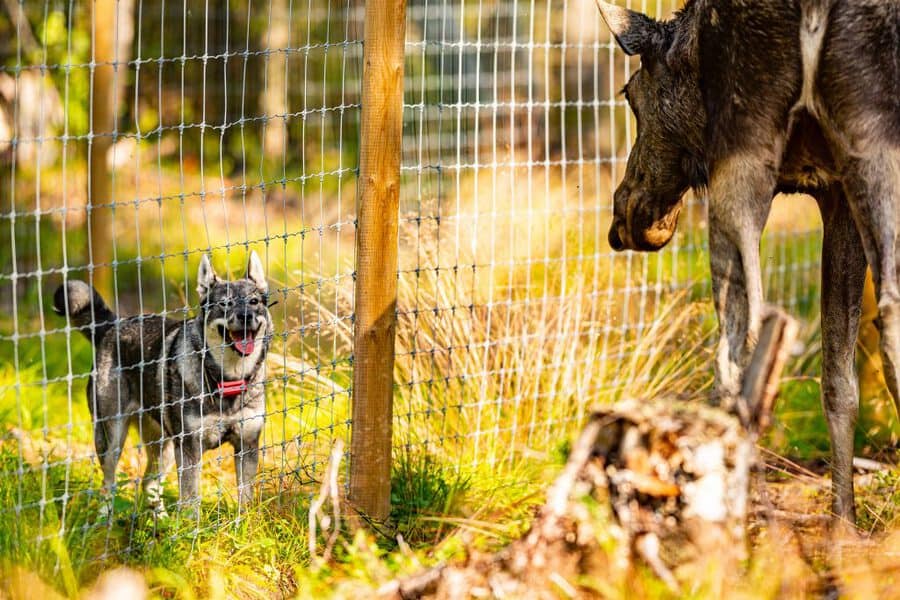
The feeling of being out in the woods and waiting for your first buck sight of the season is quite unmatched. The only thing that can possibly improve it is having your trustworthy tail-wagging companion by your side to help with the hunt. One would think that dogs would be naturally good at tracking deer, since they’ve been doing that since their early years but that isn’t the case, unfortunately. Every dog will have to undergo a certain amount of training during its puppy years in order to become a master in finding and tracking any type of animal.
The upside of teaching your dog how to track deer is that the method could be later on applied to practically any other game you want.
The centerpiece of the whole operation is your dog’s nose and its ability to find deer tracks. It is really important to understand that the goal here isn’t to teach your dog to attack the animal once it finds it but to signal that to you and/or help you by pointing in the direction of that said animal. In the case of wounded animals, it would be even more dangerous if the dog tries to get closer.
Also, the methods that we will describe work for almost any age but it is advisable to start as early as possible (2-4 months is ideal, as with all previous training sessions).
Before you start…
The basic rules for dog training apply here as well. Wait until your vet clears your pup to be medically healthy and developed enough in order to go through full-time training. You should also spend some time socializing and teaching your pup basic commands and obedience before you move on with some of the methods I will describe below. Here is a list of a few things that you need to have prepared for the training:
- Treats (according to my dog those are mandatory)
- Short and long leashes
- Practice and running pens or large areas where you can train
- Deer blood or hide for wounded animal training (or regular scent-tracking)
- Training dummies and scents
- Hunting harness (used only during training and hunting)
- Patience and time
If you get these, it is time to start implementing some of the things we learned earlier in the article about commands, obedience, acclimatization, familiarization with the scent, and other steps.
Once you nail the obedience and bonding part it is time to learn the actual tracking methods. There are three main methods for training your dog to track down deer:
- The dummy method
- The hide method
- The blood-trail method
The dummy method
For this method, you will need some old hide that you can stuff. It also has to be scented with proper deer scent. The last item you need for this method is your pup’s hunting harness. Remember that the harness is a great tool to condition him for the hunt since he will get used to only wearing it when tracking and hunting.
You also need to be in a fairly large open area for this method. Find a place where you can easily lay out a 100ft trail. Make sure that you place a tasty treat by the end of the trail so that you reward your pup if it reaches the end.
Mark a trail by dragging your scented dummy with a rope. Then put on the vest on your pup. While doing that, try to get him excited for the tracking process with phrases such as “ready to go hunting, boy?”. Once he is amped up, walk him around the start of the trail. When he indicates that he has picked up the scent, let him loose.
Once your pup starts chasing the trail, make sure you use his harness and a sturdy long 100ft leash that you can use to pull him back once he has found the end-of-the-trail treat. Offer a lot of praise every time he has completed the task successfully.
Add a little complexity to the course each time your pup completes it. Try going around trees, through bushes, and add other obstacles when marking the trail with the dummy.
Jack’s Tip: You can also take your dog to a moose or deer hunting facility where he will be able to track and chase authentic scents made from the real animals walking around. He will also get used to the sight of the animal and won’t react as sharply every time he sees it in the future.
The hide method
This method is my favorite as it is really close to being authentic. Of course, the most scent-saturated is the blood-trail method but this one is as close as it gets to the real thing.
If you don’t have a fresh deer hide, you can use a frozen one from some time ago, as freezing it usually preserves the scent.
Drag the pelt with a rope through a course the same way you dragged the scented dummy in the previous method. For added effect, you can use artificial scents here as well.
Put on your pup’s vest and it is time to play! Give the small hunter a sniff of the pelt so that he knows exactly what he is looking for and let him chase. Remember to always give a lot of praise and treats if he does the job correctly.
This method can be used virtually with any other hide once he is accustomed to the process. If you give him fox hide he will look for the trail with that particular scent, once trained enough.
The more you replay the exercise, the better it will engrave itself into the dog’s brain and will hardwire him to become an excellent hunter in the future.
Jack’s Tip: Have in mind that deer are a major carrier of ticks in a lot of states and this is a growing issue in the country. Having a tick-prevention collar for your dog is a great idea.
The blood trail method
For this, you will need some deer blood. You can either use a fresh one, if the season is right, or have some frozen from the previous year. Mix 2 ounces in a gallon of water and spray them in a trail as long as you want. I would advise starting with around 80-120 feet and slowly working your way up.
Walk backward when spraying the blood and water mixture as this will also cover your scent.
Put the vest on your pup and let him sniff the blood. Once he finds the trail, give him the treat to reward that. Also, put a treat at the end of the trail to further reward him if he gets to the end.
Keep making the trails harder and harder until you are sure that your pup is ready to take things to the next level.
Choosing either of the three methods is going to work well for your pup as long as you practice often enough and are consistent. Younger dogs have a small attention span and they need constant training if you want the knowledge to stick with them throughout their life.
My personal suggestion is to mix all three of these methods just to keep things different for your pup. That way it will get the most diversity out of its training and become far more experienced than dogs that have been trained solely under just one method.
If you want to learn more about hunting deer with or without a dog, check out my full detailed article on some of the best deer hunting tips for beginners.
Shed hunting dog training
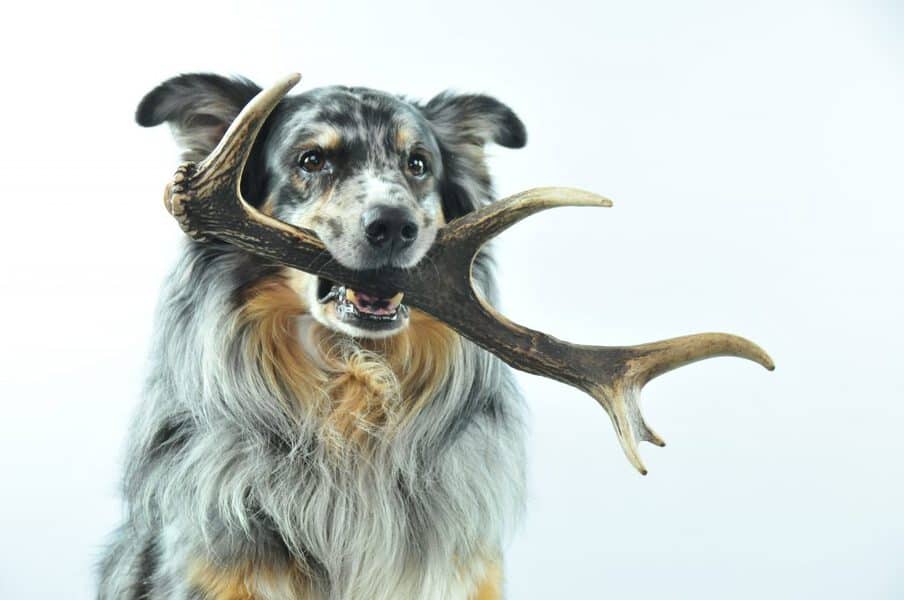
Looking for shed antlers is a fun activity that can involve a lot of people but is often tiresome and can take a while before you find what you’re looking for. Having a four-legged shed hunting machine with you will definitely improve your experience and help you find more antlers in a shorter period. Plus, all that happens in the form of play so it is also a fun activity out with your companion.
Training your dog to find shed antlers can be divided into these steps:
- Throw and fetch stage
- Identifying the shape and scent
- Introducing a real antler
One major aspect of the training, that is different from the other types of training regimens, is that here exercises are less frequent and far shorter. Train for no more than 20 minutes, 3-4 times per week. This will keep your dog from overworking or stressing out too much. remember to keep a positive attitude along the process and always reward achievements and good behavior.
Throw and fetch stage
In order for this training to be successful, your dog must first learn how to retrieve anything you throw. Balls, sticks, or toys are all excellent choices. This will calibrate your dog to find items and bring them back to you.
Praise and reward the dog every time he brings the item back to you and puts it down. Bonus treats if he sits down and waits.
Identifying the shape and scent
Once you are done with the fetching exercise and your dog successfully retrieves anything you throw, it is time to get a soft replica of an antler. These will prevent accidental injuries since the real ones can poke your dog if it isn’t too careful in the beginning. This antler dummy will let the dog get to know the antler shape better.
Jack’s Tip: To eliminate distractions, you can throw and play fetch with the soft antler in a hallway. As the dog gets better, move onto more open areas, and eventually fields that are similar to the ones that you will be hunting antlers in.
Now is also the time to create your own command for shed hunting. The most common one is “find the shed” even though you have total freedom over what your signature command will be.
Introducing a real antler
The first thing you have to do when you give a real antler to the dog is let it chew for no more than a few minutes. This will let the dog get a sense of its hardness, taste, and consistency. Also, now is the time to let the dog know that this isn’t a chew toy, but rather something that he must treat with care and return. Reward every time he brings back the antler without chewing on it.
After these three stages, it is all a matter of perfecting your craft. Keep drilling until your dog is a shed-hunting master!
Training your dog to hunt foxes
Fox hunting has been a long-lasting tradition, especially in places like Britain. Still, due to a number of issues, it is now forbidden to hunt foxes with hounds and other dogs in the UK. Canada and the USA still allow fox hunting but each state has its own regulations and rules which you must follow.
In terms of training, the process is very similar, if not the same to training your dog to hunt deer.
The stages of the training are as follows:
- Socializing your pup
- Introducing it to its name, basic commands, and scents around the area
- Letting it become accustomed to the type of area in which you often hunt
- Introduce the pup to fox scents and dummies
- Train with scents, fox hides, or fox blood
- Create more and more complex trails until the dog gets used to using its nose
- Reward and praise each time the dog finds the trail and gets to the end
- Go out and enjoy!
Foxes are very intelligent and are also quite fast and agile. However, that isn’t a match for a well-trained nose. Training your dog to hunt foxes is a lengthy process that spans some 12 months before the dog gets really good at the job.
The goal operation is simple: familiarize the dog with the scent of foxes and start creating trails for him to follow. Put treats at the end of each trail and diversify the routes as much as possible.
An older experienced fox will make twists and turns which are almost impossible to replicate but a well-trained dog can track it no matter what.
Fox scents, pelts, and blood from a fresh hunt are some of the best ways to accustom your dog to the trails foxes usually leave behind.
Mice hunting dog training
Most dogs have a natural drive to go after prey, especially small ones. But how would a domesticated dog handle a fast-moving mouse that knows how to hide really well? Well, it can’t. This is why dogs require training to a certain degree if you want them to become proficient mice hunters.
Breeds like most Terriers and even Dachshunds have been bred to specifically hunt small prey like mice and rats
Overall, mice catching isn’t very hard for any dog and once it knows exactly what it is doing, this will be a full-time job, and dogs love having a job!
A hard task
Mice are quite a challenge for any dog. They are really fast and super small in comparison to other game dogs that have been bred to hunt. They also hide in small holes in the ground which require some work to dig up. Even if larger dogs have better prey drive, smaller dogs can be just as aggressive towards small prey. Smaller breeds also have the advantage of fitting easily into tighter spaces such as behind your furniture, holes in the ground, etc.
It is important to teach your dog that this game of catching mice has certain rules. That is because the dog might be good at locating them but would probably have no idea about what to do with them once it catches a mouse. This is why you need to introduce it to mouse chasing as early as possible with various exercises and scented dummies. Here are a few methods:
- Toy mouse method
- Real mouse method
- Follow the scent method
These methods are very similar to all the ones that we used in deer and fox hunting. The key here is to introduce your pup to the mice’s scent as early as possible. Mice dummies can be added later to the training.
Make trails with the scented dummies and add a treat at the end of the trail to reward sticking to it until the very end. Reward your pup every time he locks on the scent as well.
With some daily training in your pup’s first year, mice hunting will become a daily routine for him and quite an easy task as well.
Training your dog to hunt wild hogs
Hogs are becoming a bigger and bigger issue across the United States each year. That made a lot of people turn to hog hunting as their primary hunting game. Some hunters really prefer hunting unaided as that adds to their experience of tracking down hogs, learning their habits, and ultimately finding and shooting one.
There are a lot of methods used in hog hunting, especially since feeders, baiting, and night hunting are generally allowed across the USA. Still, you should check with your state’s hog hunting regulations before moving on with your hunt. One particularly successful method is simply using a dog to do most of the work. This is, in fact, a tradition that dates back to the 18th century in the United States.
Bay dogs and catch dogs
To hunt hogs, hunters use two types of hunting dogs – bay dogs and catch dogs. The whole purpose of the bay dogs is to locate a scent, track it to the hog, flush it out, and corner it. Once that is done, they start barking to alert the hunters. Upon that signal, the hunters release the catch dogs which have a role in incapacitating the hog and pinning it down until the hunter comes and either catches it or shoots it.
Logically, catch dogs should be big, strong, and aggressive breeds that are capable of holding a wild boar down. They do that by grabbing it behind its ears. That task is quite dangerous, so the importance of the dog is big and strong is significant.
Bay dogs are lighter and swifter on their feet. They are also better-tracking dogs. To prevent unnecessary injuries to them, hunters often equip them with vests that help protect their necks and chest.
There are some dogs that can be both bay and catch dogs but most hunters prefer them separated. These dogs are usually trained in specific areas with domesticated pigs (slightly smaller than the dogs). Also, when going to the hunting site, these dogs should be transported. The most common method to do so is via off-road trucks and dog kennels.
These hunting dogs are also often equipped with tracking collars in case they stray too far from the hunting group. Apart from that collar they are almost always equipped with protective gear for their tail, chest, neck, and even paws.
Both baying and catching dogs’ training starts after they are at least 12 months old. There are several methods that all include introducing the pig to them and making them excited about it. Another very successful way of raising such hunting dogs is by putting them in a pack with an experienced hog hunting dog. That way, they can take in most of its habits and techniques.
Click here to find out more about hog hunting and everything a rookie must know.
Other animals your dog can help you hunt
Some of the other animals your dog can hunt are:
- Ringneck pheasant
- Raccoons (coon hunting)
- Cougars
- Other predators (region-specific)
- Quail
- Grouse
- Rats
I didn’t include those as individual steps since training for each of them resembles a similar training process that I’ve included. For instance, ringneck pheasant, quail, and grouse training have an almost identical approach and steps to duck hunting or waterfowl hunting in general with the exception that you mostly train on the ground rather than including water training.
Varmint and rodent hunting is all practically the same and introducing your dog to the scent and teaching him to stick to a trail is at the core of the training process. Raccoons (coon hunting) are identical to squirrel hunting in terms of training steps too.
As a whole, a dog can be trained to hunt quite a diverse group of animals, it just needs proper dedication and the correct steps. The hardest task is to train a waterfowl hunting dog that is also good at tracking deer or fox trails. These two hunting types are quite different for your dog and it might take some time for him/her to start recognizing the differences. If you are in a similar situation, I suggest reaching out for some help from the local hunting clubs, as they can even pair your dog with a more experienced one that is used to hunting more than just one game.
There are moments when you start noticing that your dog does things that it isn’t supposed to do, or at least not in that way. It can flinch at the sound of your rifle firing, or not bring the duck directly to you. These are some of the moments which can be quite frustrating, especially at the end of an unrewarding hunting season. Then, it might be time for a re-training…
Re-Training your hunting dog
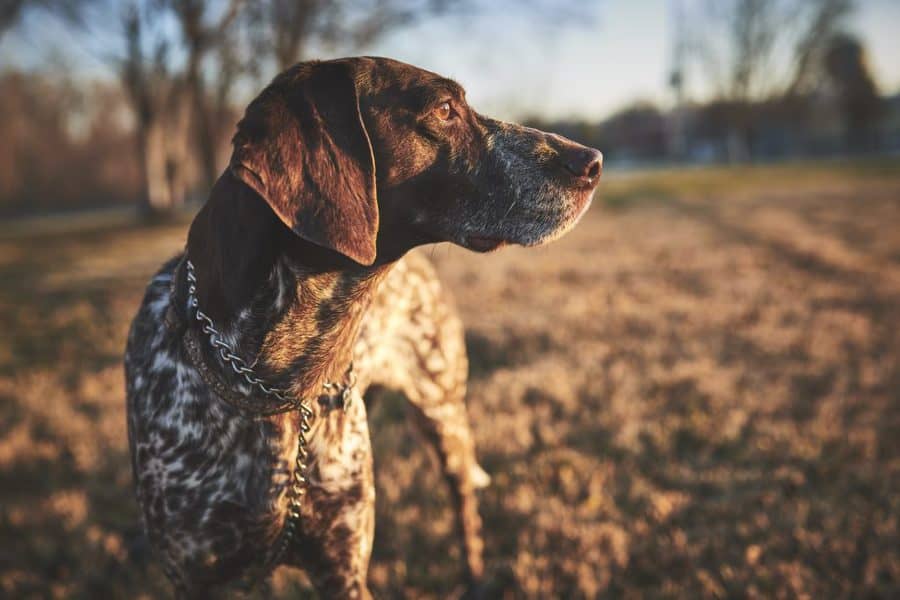
In order to understand what needs correction, we need to look at two specific places:
- The dog’s health
- The dog’s behavior
There are several health issues that might hinder the dog’s hunting capabilities, and once you rule those out by taking your dog to the vet, you can move on to the more common issue – the behavior.
Now, I know that I can’t cover this topic in-depth here but I want to at least lay out a few theories that you can follow up on and apply to your dog.
One of the most common behavioral signs of hunting training gone bad is the so-called “blinking” which is a form of avoidance. Waterfowl hunting dogs do that when they negatively associate the bird with something bad that has happened in the past. One reason for that might be the inappropriate usage of electronic collars. Another reason for that might just be an accident the dog had with a similar bird, which engraved a “bird = pain” equation in its head.
Weak foundations
Another very common issue with hunting dogs is that they have a weak training foundation. What works well in your backyard might not work at all in the practice pen, where there are a number of other dogs sniffing and chasing around. This is one of the major reasons you need to acclimate your dog to various hunting conditions more and more as the training progresses.
One of those conditions should be hunting alongside other dogs, otherwise, other dogs will always be a distraction issue when out in the open. In other words, observe what is going on around your dog when the commands seem to pass over its head and try to correct and adapt the training accordingly.
One major aspect of hunting with your dog is having positive consequences added to that. If the consequences of mistakes or any type of decision-making on your dog’s part are bad, then it will try avoiding hunting altogether. If the consequences are good, or in other words, you reward good behavior, hunting will be fun and the dog will be excited every time you go out.
This is why you need to observe your dog consistently to understand what you need to correct later when you come back home. That is the essence of re-training a hunting dog – observe why it is making the mistake and try to guide it around that issue. When you are firing, is your pointing dog moving to get a better view of the fallen bird or it wants to chase? Try to observe and take note of everything that might lead to issues in the future and correct them on time.
How to feed your hunting dog
When it comes to feeding, one of the main concerns is how often to feed your hunting dog. Should you feed it once a day? Is two or three times a day too much? Let me try to answer those questions…
The short answer is that high-performance hunting dogs gain the most benefits of a once-a-day meal plan. Now, the natural question that arises is when exactly during the day to feed your dog or how much. The answer to these questions heavily depends on your dog, its breed, body type, and habits. The best thing you can do regarding those things is to consult your veterinarian and try to come up with a custom diet for your pup. Even then, you will most likely adjust it a time or two judging by your dog’s behavior and energy levels.
The thing with hunting dogs is that they don’t depend on blood-sugar levels as much as humans do. They don’t get hyperglycemic spikes or hypoglycemic drops since they primarily depend on fat metabolism.
Dogs that need more than 7-9 cups of food per day might benefit more from eating twice a day. This is usually the case with very active hunting dogs that need lots of high-performance food due to extensive daily activity or even cold climates. In these cases, the bulk of the food (80% or more) should be given after the hunting or hunting exercise.
If you want to deliver more calories to your dog without feeding it more than once or twice, consider foods that are calorie-dense or highly digestible.
Frequently Asked Questions
Can a hunting dog be a family pet?
Some traditional dog breeds tend to be one of the best family pets as well. That is primarily thanks to their intelligence, social skills, and loyal behavior. Due to the intensive training, they might develop a strong bond with just one person (the hunter) but they will still be amiable to the rest of the pack/family.
Can I train an older dog to hunt?
Depending on the breed, older dogs are just fine for some type of hunting training. For instance, you can easily train an old dog to track a deer’s trail with a few weeks of training and guidance. If the dog is too old or already afraid of hunting scenarios, it might be impossible to convert it into a reliable hunting dog. Still, it all depends on the breed, the age, and the overall mental state of the dog.
Do hunting dogs require a special diet?
Some high-intensity hunting dogs might require calorie-dense dog foods or at least highly digestible ones. Hunting is a particularly exhausting activity and you should plan your daily meals accordingly.
Final Words
Learning how to train your dog to hunt is a continuous process that takes a lifetime’s worth of devotion, frustration, headaches, and mighty triumphs every now and then. That period will be full of regressions, baby steps, and quantum leaps, which will only strengthen the bond between you and your cheek-licking best friend. Take breaks every now and then, as you will both need them.
No pup will be pitch-perfect throughout the whole process, and you shouldn’t expect perfection from it. The road will be long and rough but the end result will justify it all. The moment your dog points at his first ring-necked pheasant or dives in to retrieve its first duck will be the moment in which you realize that it was all worth it. Every moment of it.
